First off, in order for the title to work, you have to say it in your best (or worst) Canadian accent. Now that I’ve covered the ground rules, here is my blog post for the day!
The morning started off with a peek through the window in my room. Fog clouded my view of the bay below – we would have to wait for this to clear before we could take the boat up river. I packed my bag for the day and went out to breakfast to discuss the plan. As I munched on Cheerios and toast, the sun started to burn through the fog. By 9:00 AM the fog had almost completely lifted. We organized the research coolers for the day and packed up the van. One last check of necessary materials: bear spray – check, pocketknife – check, water – check, satellite phone – check. By 9:45 we were on the road down to the Hunters and Trappers Organization (HTO) to meet Barb and our boat driver for the day, David.
As we pulled up several men were bringing their morning’s catch to Barb and David. In each bag was an arctic char measuring between 24-44 inches. The HTO prepares and freezes the meat and will distribute the food to the community to help those people who do not have enough to eat. There is a strong network of support in the town of Kugluktuk, and we have noticed this in the short time we have been on the ground here. For instance, when we mentioned to Barb that we would like to have a boat to take samples up river, she called David who was willing to give up several hours of his day to help us with our project. Each step along the way, members of Kugluktuk have made us feel welcome despite having wandered far from home.
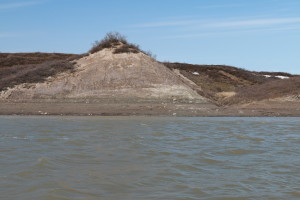
We grabbed our life jackets, donned our waterproof raincoats and pants, and took off for the shore to meet David at his boat. One thought kept coming to mind as we neared the frigid water of Coronation Bay – “one minute to control your breathing, ten minutes to use your muscles, one hour before you lose consciousness.” This past spring break, while individuals flocked south to find warm, sandy beaches, Greg and I went to the Pacific Northwest, to the University of Washington, for several classes to prepare for this summer. We were taught about small boat safety, bear safety, emergency preparedness, and small river crossings. Along with Matt Alkire, we learned to always wear life jackets on the water (of course…), to tell others where you are going, stay calm in emergencies, and many other life-saving bits of information. Perhaps most useful and impressive was the section on hypothermia. In the event that one of us were to fall into water in the Arctic, it is important to remember how much time you have to do several important things – “one minute to control your breathing, ten minutes to use your muscles, one hour before you lose consciousness.” This sequence of events was brought home by Dr. Gordon Giesbrecht in this video. He staged a scenario where he fell through the ice on a frozen lake. He talked through each of the steps in the moment, while he is experiencing the symptoms from his predicament. He emphasized that the goal of the video is to save lives. The lines run through my head once more as we pull up to the boat – “one minute to control your breathing, ten minutes to use your muscles, one hour before you lose consciousness.” Okay, maybe I’ll just focus on not falling in…
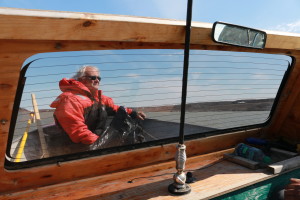
We tossed our gear into David’s boat and strapped on our life jackets. With a nudge from a man onshore we floated free and started heading up the shoreline toward the mouth of the river. A light fog wisped around us and the icy air just above the water revealed any exposed skin. David guided the boat skillfully, avoiding low points and other objects in the river, including chunks of ice.
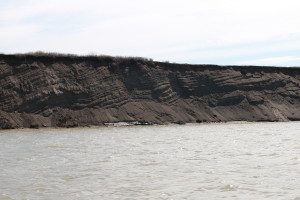
The hills on either side of the river rose sharply, exposing layers of sedimentary rock, deposited long ago as sediment fell out of the river and settled on the river bottom near the mouth. We stopped about a mile upstream where the channel narrowed. In order to get a better profile of the river, we decided to collect three measurements, one on either side and one in the middle. We pulled over to the shore and hopped out into the mud.
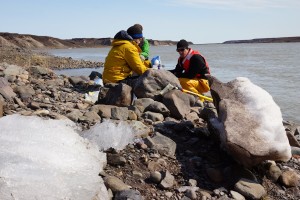
The shore was muddy, despite being covered in vegetation. Only a few days ago, the water level was several meters higher from the pulse of ice and freshwater flowing downstream due to the river breaking up. We grabbed our gear and slogged to a place on the shore not covered by mud to start sampling.
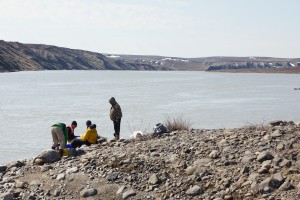
Greg and Matt reviewed how they wanted the samples collected and re-emphasized the importance of preventing contamination.
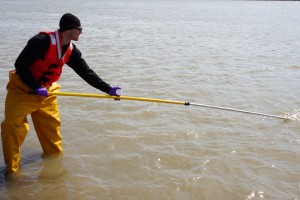
It was pivotal to keep any dirt, sand, mud, hair, and other objects out of the water once it has been pulled from the river.
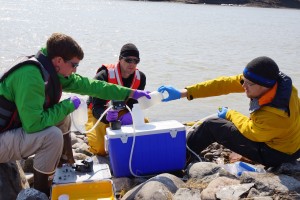
In order to collect several liters of water ‘quickly’ we used something called a peristaltic pump. Despite the complicated name, it operates in a similar way to how we swallow food. Tubing runs through the middle of a drill-operated pump that squeezes water through the tubing and into our bottles. It took us almost an hour to fill all of the bottles for the first site, partially due to some complications with the pump. After we completed these measurements we lugged our equipment back to the boat and set off for the middle of the river.
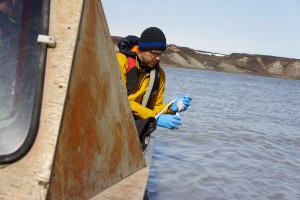
The river measured approximately 200 meters across at this narrow point. We set anchor in the swift current and began taking samples.
The purpose of this study is to obtain a chemical fingerprint that can be used to determine where the water from this river (and the six others we are measuring) goes once it enters the Arctic Ocean. The interaction between freshwater and saltwater is interesting and complex. In most cases freshwater is less dense than seawater. Due to its density, freshwater behaves in a similar way to oil that sits “on top” of water. The subtle differences in density are enough to prevent water from deep down to circulate to the surface in the Arctic Ocean. This property (which is a simplification of the overall process, but I don’t want to bore you with all the details here) is what allows ice to form in the Arctic Circle. Similar to salt being thrown on the road and sidewalks during winter, saltwater in the Arctic Ocean freezes at much lower temperatures than freshwater. This project will provide the first set of measurements from small Canadian Arctic rivers in the hopes of seeing how much freshwater they contribute to this cycle and where this water goes. Still with me? If I set you adrift somewhere, I’ll toss you a rope and pull you back into the boat with us!
We finished collecting samples in the middle and far side of the river. After sitting in the boat for almost three hours, my hands were nearly frozen despite being bathed in sunlight all morning. The temperature was still a chilly 5 degrees Celsius (41 degrees Fahrenheit) and windy. We finally pushed the boat off from the shore and sped off downstream. The wind had picked up since we left, which made the ride back much choppier. A few large chunks of “candle ice” melted on the shoreline, unable to resist the pressing waves of summer.
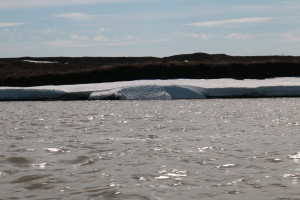
By tomorrow these chunks of ice will be gone. We returned to the beach and unloaded the boat. We thanked David, our captain, and he pushed off into the Bay to begin checking nets again for more Arctic Char.
We drove back to the Inn and brought our gear inside. My stomach was growling having missed lunch, so I decided to wander to the Co-Op store for a snack. You know how they say never shop when you are hungry? Well that point becomes even more apparent when the items you would normally purchase as snacks are two or three times more expensive. I bought a bag of chips, gummy worms, and a few bananas and spent $20.00. My wallet winced a bit as I put the receipt inside, but alas my stomach’s grumbles won out. I walked back to the Inn munching on my snacks, occasionally stopping to talk to people who were selling some amazing, hand-carved trinkets. I mentioned that I would be interested in a carving of a whale or bear, but did not want to buy anything today. Roy, the man who was showing me his carving, nodded and said he would see what he could do. This would not be the last time I would hear from Roy.
Dinner was another delicious meal provided by Johnny and Nadene. We all left the table thoroughly stuffed. For the second time in two days a thunderstorm moved over the town of Kugluktuk. Lots of lightning was accompanied by heavy rainfall.
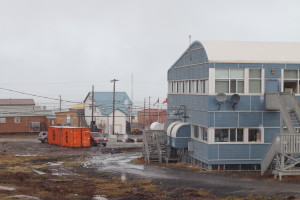
This storm hovered over the town all night long. With nowhere we needed to be after dinner, I sat on the porch of the Inn and watched the storm roll by. Two unseasonal storms in two days. Today’s sample collection was a success – the first trial for a three-year study. Tomorrow we plan to show Jorgan and Christian, both 19 years old, how to collect the samples. They will have a part to play in helping their town, Kugluktuk, understand how their Coppermine River contributes to the Arctic freshwater input. The fact that they are enthusiastic about the opportunity shows human nature’s ability to take on challenges with unknown results. That individuals are trying to redefine their community given new circumstances gives me hope.
